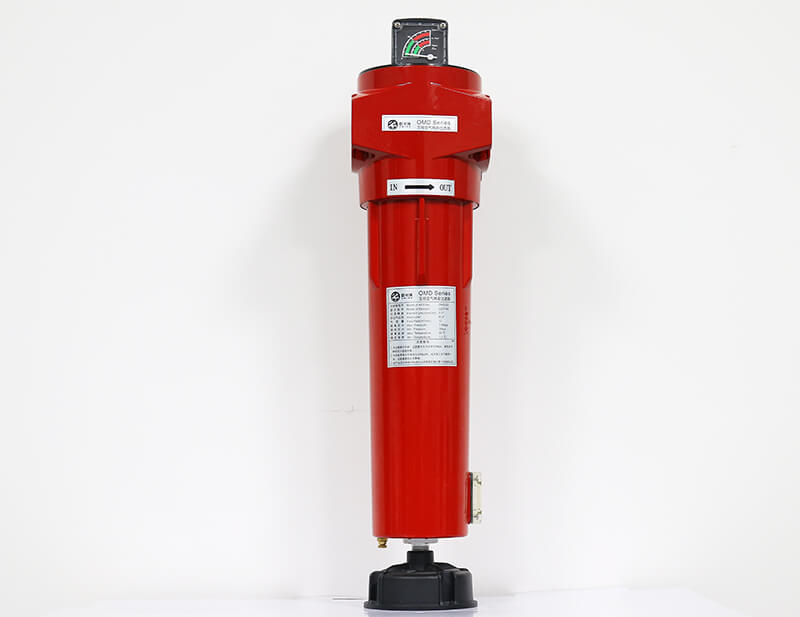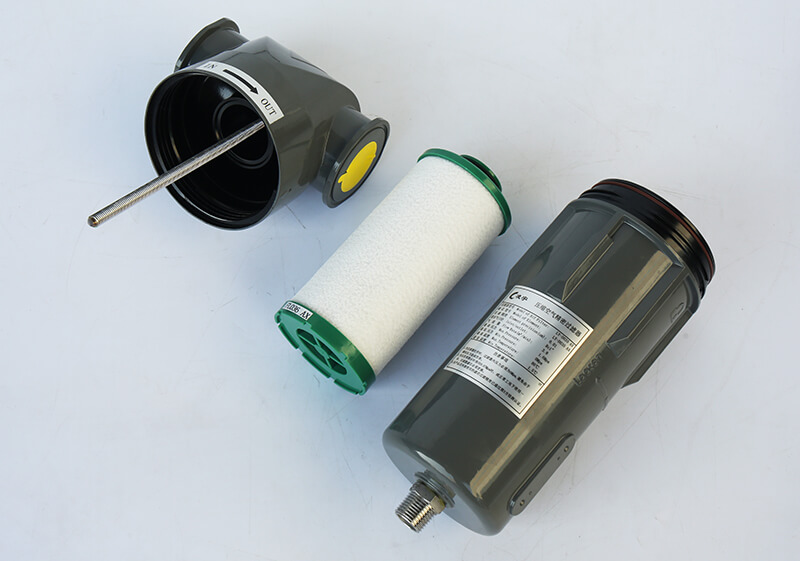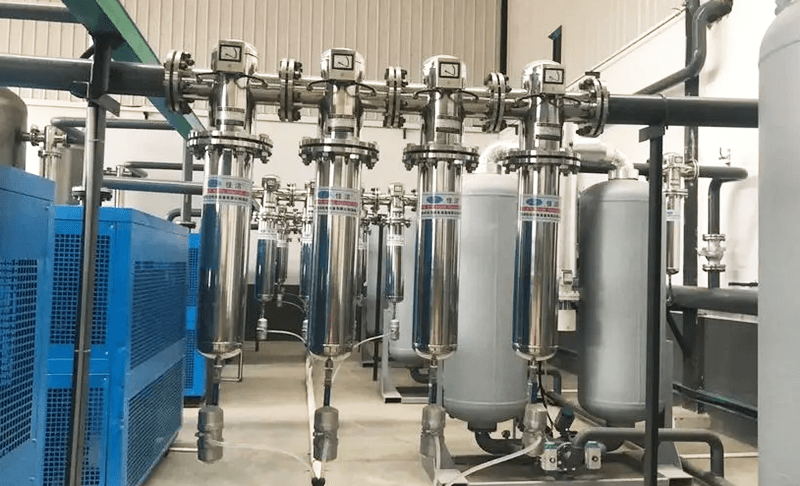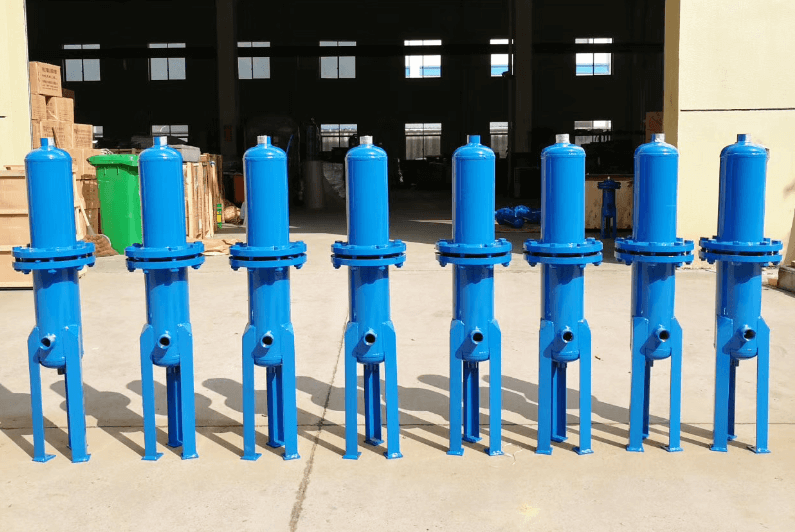There can be many compressed air filter types. For example, we commonly use cast aluminum filters. It requires a stainless steel filter if used for the food and pharmaceutical industry. And these filters are usually at atmospheric pressure. That is, the working pressure is 7~10 bar. However, some industries need medium and high-pressure filters. For instance, laser cutting needs at least 16 bar pressure. Some other industries even need 40 bar filters.
But here, we distinguish the filters from the filtration accuracy and function. In this article, we list 9 different types of air compressor filters. It helps us to select the right model.

What is Compressed Air Filter?
We know that compressed air is not clean. The surrounding air is full of contaminants. Moreover, the working process of the air compressor also produces water, oil, and impurities. So we need filters to clean the air and protect the equipment. To know the types, we need to understand what is compressed air filter.
In the air compressor system, the filter is an important part. The filter and dryer consist of air treatment equipment. Among them, the function of the dryer is mainly to remove water. Although it can remove part of the oil and impurities, most still exist in the system. The purification function of the filter is much wider. After filtration, compressed air can achieve dust-free, water-free, and oil-free quality. It can even reach a sterile and odorless level. Therefore, filters can effectively remove solid particles, water, water vapor, aerosols, and oil.
Air filter for compressed air mainly includes filter element and housing. Of course, many filters also have spare parts. For example, we can add functional accessories like a manual drain valve, auto drainer, differential pressure gauge, and sight glass.
7 Types of Compressed Air Filter
As mentioned above, we can classify the filters according to various principles. For example, it is classified according to the installation position in the air compressor system. So divide it into an intake filter and a pipeline filter. That is, install it at the intake port of the air compressor. Or install the filter in the air pipeline network behind the compressor.
A common way to classify is by the filter function. There are various air compressor filters, such as water removal filters, particulate or dust removal filter, oil removal filter, deodorization filter, and bacteria removal filters.
1. Coalescing Air Filters
This is one of the most common compressed air filter types. It primarily removes water, oil, and aerosols from the air. They also prevent contaminants from re-entering the air. Of course, it also removes fine particles from compressed air. Trap them in the filter medium. But, it needs to change the filter element regularly. Otherwise, it can lead to a drop in pressure.

| Filtration Class | Filter Type | Particulate/Vapor/Aerosol Removal | Maximum Oil Residual Volume |
| PF | Coalescing | 5 micron | N/A |
| AO | Coalescing | 1 micron | 0.6ppm |
| AA | Coalescing | 0.01 micron | 0.01ppm |
| AX | Coalescing | 0.01 m | 0.001ppm |
In the above sheet, some companies call them Q, P, S, H. This means the pre-filter. Its filtration accuracy is the lowest. We often install it between the refrigerated dryer and air compressor. It can play the role of pre-treatment and protection.
AO filter can remove liquid and solid particles as small as 1 m. Usually, install it behind the refrigerant air dryer. It can also protect the AA filter. An AA filter can remove liquid and solid particles as small as 0.01 m. It is a precision filter. In addition, AX is a high-precision filter. Its oil residual volume can reach 0.001 ppm. So we usually call the AX filter the oil removal filter.
2. Dry Particulate Filters
There are two kinds of filtration accuracy for choice. That is 1 micron and 0.01 micron. We call them AR and AAR filters. They are like AO and AA filters. But they don remove oil. Why do we need the dry particulate filter?
We know that desiccant dryers use adsorbents to remove water. Activated alumina and molecular sieves have a lifetime. Generally, it is about 3 years. Besides, the compressed air will cause an impact on the adsorbent. Over time, it will produce a lot of dust. So we must install a filter after the desiccant air dryer. This prevents the particulate from entering the back-end equipment and instruments.
3. Activated Carbon Filter
There are two kinds of filtration accuracy for choice. That is 1 micron and 0.01 micron. We call them AR and AAR filters. They are like AO and AA filters. But they don remove oil. Why do we need the dry particulate filter?
We know that desiccant dryers use adsorbents to remove water. Activated alumina and molecular sieves have a lifetime. Generally, it is about 3 years. Besides, the compressed air will cause an impact on the adsorbent. Over time, it will produce a lot of dust. So we must install a filter after the desiccant air dryer. This prevents the particulate from entering the back-end equipment and instruments.
4. Air-water Separator
This separator is different from other compressed air filter types. There is no filter element inside. So there will be no element replacement cost. There is a centrifugal cyclone-type mechanism. The main function is to remove water. It is generally used in the main inline. The working principle is as follows: compressed air containing water enters the separator. They move in a centrifugal downward slanting motion. The water is separated due to the reduced speed. On the other hand, the separated liquid flows through an automatic trap and is discharged. The efficiency of removing liquid water is more than 98%. Generally, install it between the refrigeration air dryer and coalescing filter.

5. Steam Sterilization Filters
In addition to water, oil, and impurities, compressed air also contains various microorganisms. They are generally attached to the dust. Most of them are in the range of 5-20 m. Harmful bacteria are amazing in their ability to reproduce under favorable conditions. If effective filtration is not carried out, it will bring harm. In particular, it harms processes such as medicine and food. For this reason, the sterilizing filter uses periodic sterilization to intercept microorganisms. Finally, get the sterile air. At the same time, its structure is also different.
The filter element must withstand high temperature and high-pressure steam. Generally, it uses a PTFE filter element. In addition, the filter housing must be stainless steel. Usually, installing a sterilization filter after a dry particulate filter.
6. Compressed Air FRL Filter
This is a combination of filter, regulator, and lubricator. It is also one of the popular compressed air filter types. But the FRL filter is different from the above filters. Most of them are inline filters. But the FRL filter is not. We usually use it for compressed air branch piping. The branch pipes are connected to terminal equipment and instruments. The inlet/outlet size is small. So its air capacity is usually much less. In addition, the filtration accuracy is lower than the above filters. Of course, the working principle is also different.
7. High-efficiency Oil Remover
Sometimes compressed air contains a lot of oil. Now, it is difficult for a single filter to remove oil effectively. Therefore, we need this highly efficient oil remover. Its working principle is cyclone separation, inertial separation, and microfiber filtration. So it is different from other compressed air filter types.
There is a cyclone baffle inside. The shell is made of a steel welded pipe tank structure. Its effect is good, and the service life is long. This oil remover can effectively remove water and oil mist. The filtration accuracy is 0.01 microns. And outlet oil content is less than 0.01 ppm. We usually install it before the desiccant air dryer.

Select The Right Compressed Air Filter Types
Not all compressed air applications are the same. Different applications need different filtration levels. Therefore, it is necessary to understand the specific application fields of the air compressor. Only then we can select the proper air filter for compressed air. Let us take an example to explain the filter selection.
There is only the refrigerated air dryer. The filtration grade is ISO-8573-4 grade. At this time, generally use the AO and AA filters behind the dryer. For example, industries such as civil engineering and pneumatic conveying have low requirements.
There is also only a refrigerant dryer. The filtration grade is ISO-8573-3 grade. Now, the filtering requirements are higher. For example, pneumatic tools and cosmetics have such requirements. Then you can add ACS and AX filters.
The system has both a refrigerant dryer and a desiccant air dryer. The filtration accuracy level is also ISO-8573-3 level. For example, painting, coating, blow molding, electronics, and printing industries have such requirements. Because there is a desiccant dryer, adding a dry particulate filter at the back is necessary. At the same time, it requires an AX oil removal filter before the dryer.
Likewise, there are both refrigerated and adsorption dryers. The filtration accuracy level is also ISO-8573-2 level. For example, photographic film production and the laser industry are demanding. At this time, an activated carbon filter must be added in front of the dryer. It also requires a particulate filter after the dryer.
Finally, some industries, such as pharmaceuticals and military industries, need the filtration accuracy level to be ISO-8573-1. In this case, an activated carbon filter is required before and after the dryer. Likewise, the rear end needs a particle filter as well.
